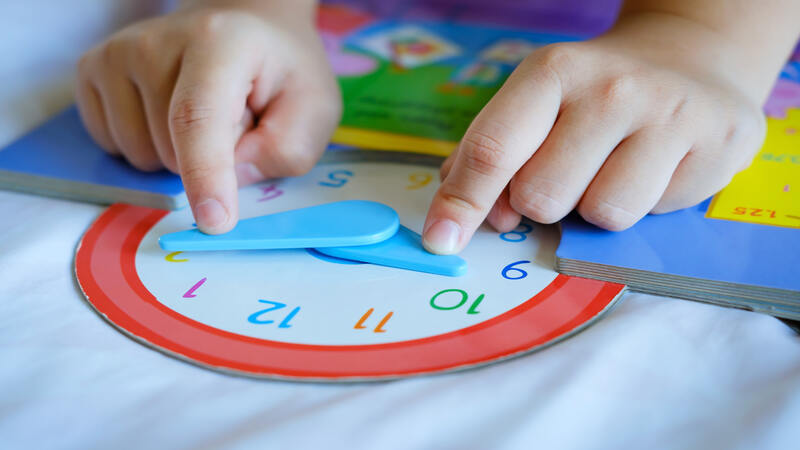
Here is another developmental milestone to watch out for in school going years.
By the time your child grows out of toddler hood, he would become more independent – he will be able to go to do basic morning routines himself, he will be able to go to the apartment’s play area alone, and he will be happy going to his friend’s house without wanting his “mama” in his line of sight. Around this time, it will be very useful if the child can tell time. It will help him feel more empowered and independent to get to his 5 pm football class, if he does not need to ask you every 2 minutes “is it time yet?”. Many kids learn to tell time from digital clock faster because, well, it is easier. Analog takes longer. So, the first question you should ask is:
When Can I Teach My Child To Tell Time?
There is no fixed answer for this. It depends on how good your child is with his numbers. There are essentially three requirements your child should satisfy before you can start the “time-telling training”:
- The child should be able to read numbers
- The child should be able to count till 60
- The child should have a basic idea of the multiplication table of 5
Now some of these concepts might feel far stretched for a 5 year old. But think of it this way, unless the child knows how to count till 60, how can you explain to him there are 60 minutes in one hour? Similarly, unless he understands the concept of “5, 10, 15, 20” etc., how will you explain to him how the minute hand works? So, the first step is clearly get your kid to ace in the three requirements above.
You child meets the criteria? Great. Here is the next step!
How Can I Teach My Child To Tell Time?
-
- Get a clock: The first step is to get a big and large faced clock where numbers are written as 1, 2 etc. and not in Roman numerals. The clock should be light weight and ideally should not have a glass outer casing so that you can move the short hand and minute hand freely. The clock should also have minute markings. Nothing fancy, let us not make it more difficult for your child than it already is
- Familiarize short hand: The first step is to get the hour right. Place the minute hand at 12 and do not move this. Now move the hour hand to 1. And explain to the child that when the hour hand is at 1 and minute hand is at 12, it is “1 o’ clock”. Repeat this for 2 o’ clock, 3 o’ clock and so on. Use this example to explain the concept that when the minute hand is at 12, it is “_ o’ clock”, the dash to be filled by the number where hour hand is
- Familiarize minute hand: Next is the more complicated task of explaining the long hand or the minute hand. This time keep the hour hand at one location, say 1. Now keep moving the minute hand to 1, 2, 3 and so on, and explain to him how it means 5 minutes, 10 minutes, 15 minutes etc. (this is where 5 multiplication comes handy). Once the child has masters 5 minutes to 55 minutes (we have already covered 12 means “– o’ clock”), then move the “off marks” like 6 minutes or 17 minutes. Encourage her to keep moving the minute hand around and tell what minute it is. This will take time and patience

- Teach how to read both hands together: Once both hands are mastered individually, time to put the understanding together. Start small. 3:30, 1:15, 9:30 and so on. Once he has mastered the hour-hand and minute-hand combinations of all multiples of five, progress to off-marks, like 1:07 and 8:24
- Quiz him: Once a certain concept is mastered, quiz him often. Practice will make his skill perfect
- Let them quiz you: Encourage him to quiz you as well. And think out loud when you answer him (e.g.: “So the small hand is on 4…so it is 4 something…and the minute hand is between 5 and 6, so the minute is between 25 and 30…oh got it, it is 4:27”)
- Use other media: You can make it a bit more fun by going beyond the actual clock and using other media. For example, there are books that have a clock face and a story line that follows different time of the day. That is an excellent way to get your child interested in time telling. Another example is time telling toys. Do a simple search I any popular ecommerce website, and you will see there are many educational board games available on this subject. And finally, search your phone’s app store. That would not be disappointing either
- Make your own clock: If your child is into arts and crafts, an excellent way to engage him in time telling is to make your own clock. You can do this one a round card board cut out, or better still, on a paper plate. Once the clock is made, you can decorate it, make it colorful and use a tall and small pencil as makeshift minute and hour hands
Good luck!


1 Comment
all the point that you mention here are adorable way to teach a child. thanks for sharing such kid information. 🙂